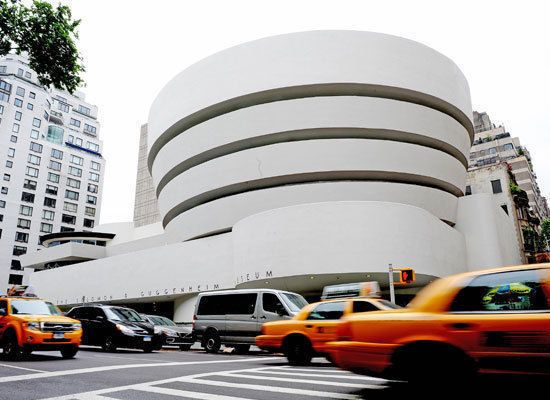
When I go to a museum exhibition, I know what to expect. I'll look at objects hanging on the wall and respond to their color, shape and content. The impressions I form--subconscious or not--get tucked in my mind for later contemplation.
The current exhibition at Guggenheim NY by London born Tino Sehgal blasts this museum paradigm to smithereens. For the first time in its 50-year history, the rotunda walls are bare; and for the first time in my lifetime of museum going, I am shaken to the core.
So, just what is going on here? Firstly, it was an extraordinary experience to simply witness naked walls in this beloved museum, as if Frank Lloyd Wright himself had returned to see his masterpiece as unadorned as on the day it was unveiled. And yet, today, people mill about normally in a kind of Emperor Wears No Clothes scenario. I felt like shouting, "Hey guys, this is weird, right?"
On the ground floor a couple in street clothes roll around, coming in and out of a tight embrace in a slow motion, taffy-like dance. They kiss, caress, standing or lying down, eyes open or closed. No one approaches, but everyone is a voyeur from ground on up, leaning over the rails at each rotunda level, gazing down at this part-performance art, part dance piece.
I approach the first ramp where an elfish boy of nine or ten greets me with a surprisingly firm handshake and asks me what Progress means. I tell him some sort of thing about each of us doing the right thing and trying our hardest to make the world a better place.
"Can you give me examples of that?" he inquires. The chat goes on for another minute until I am handed off to a young woman, bright and cheerful and curious about my thoughts on Progress, which the little boy dutifully relays to her. I feel cared for, cared about and in good hands.
All around me similar situations are unfolding, as other 20-somethings take the visitors that the children pass on. Ok, so I get it. This will continue to the top of the rotunda with my guides getting older and older. Alex interrupts Claudia and me, just as our conversation shifts from Progress to Ayn Rand and individualism. I'm not sure I want to go with Alex to the next rotunda level. I'm enjoying Claudia, but I don't have a say. I'm part of the art-making taking place at this moment in this museum, but I also feel like flotsam and jetsam, pushed by an unstoppable current.
Towards the top, a 70-something Ann whisks me away from Alex to tell me about a recent New York Times editorial about a devastated Haiti, a dialogue that somehow leads to our musing about empathy. I wonder if these folks are in character? I ask Ann and am reminded about when my husband tried to get Cinderella out of character at Disney World, much to the amusement of our then very young children.
On the way down, I feel both exhilarated and bereft. Bereft because no one is talking to me anymore. I listen to snippets of conversations new visitors and their guides are immersed in on the way up. I feel a smidge of envy that my moment in this fluid art experiment is finished. I am exhilarated because for that brief time, I was engaged in some heavy thinking and talking with strangers, the kind of people you wouldn't glance twice at on the subway. I feel an odd connectedness, the kind we yearn for, but maybe only experience with family or friends. And yet, I am uneasy to have been part of a forced, rehearsed cultural experiment. There is something Big Brotherish about the guides. I am relieved, at least, that they are not in uniform or matching t-shirts, but wearing their own street clothes.
I am alone again, as I continue to wind down the ramp. This is the feeling I normally have in museums, as I prefer visiting exhibits alone. My attention shifts to the marvelous engineering and architectural feat of this place, so much more apparent for the absence of colorful canvases on the curved walls. On the way up, people approached me and compelled me to talk. In museums, modern sanctuaries, one doesn't expect to be accosted. But everything was different today.
Meanwhile, the kissing and heavy petting continues on the ground floor. I stop to watch a bit more, daring myself to approach them, but knowing I won't. The Guggenheim rotunda will remain empty of things through March 10. This is Sehgal's commentary on materialism in our world, both cultural and economic. And yet, despite the emptiness, and maybe because of it, I feel a gratifying fullness as I exit the museum.
TINO SEHGAL REMAINS ON VIEW AT THE GUGGENHEIM THROUGH MARCH 10, 2010